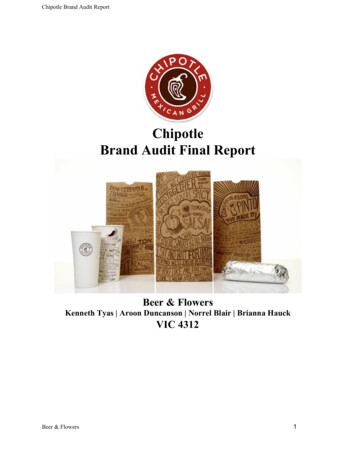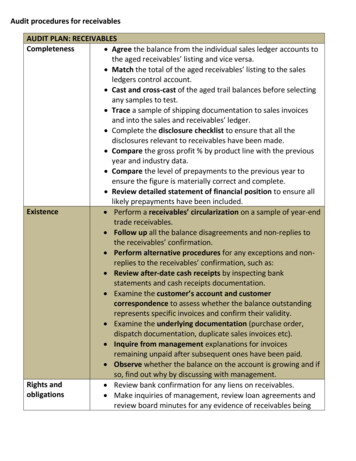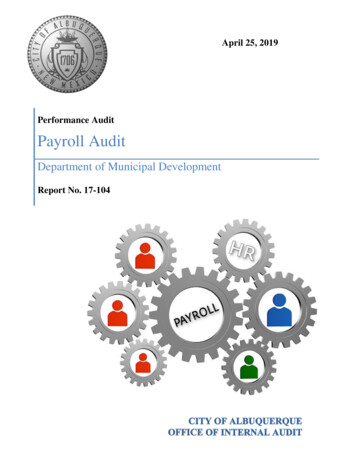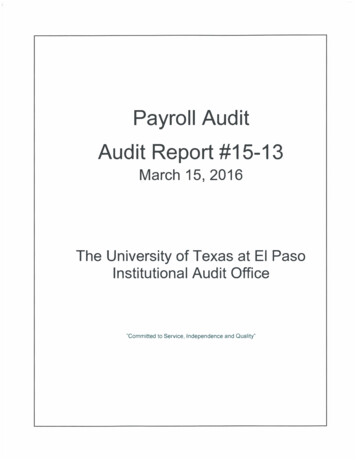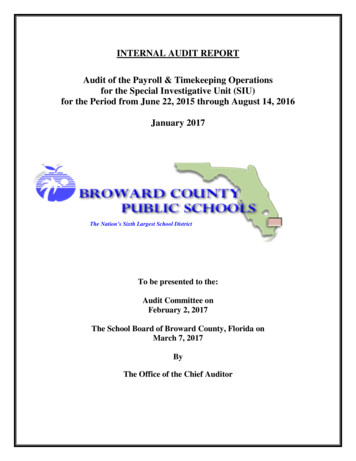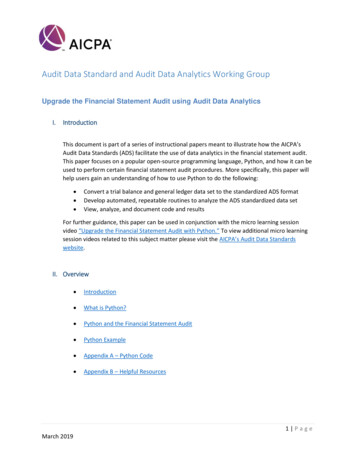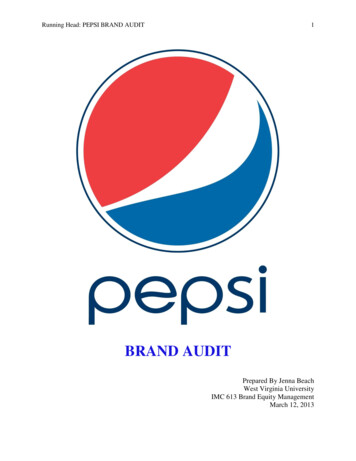
Transcription
Running Head: PEPSI BRAND AUDIT1BRAND AUDITPrepared By Jenna BeachWest Virginia UniversityIMC 613 Brand Equity ManagementMarch 12, 2013
PEPSI BRAND AUDIT2TABLE OF CONTENTSExecutive Summary . 3Brand Inventory . 4Brand Meaning . 7Brand Elements . 10Brand Associations . 11Marketing Support Programs . 13Competitive Environment . 14Brand Hierarchy . 17Brand Exploratory. 17Brand Meaning . 21Brand Elements . 26Brand Associations . 28Marketing Support Programs . 29Competitive Environment . 30Expectations of Future Potential . 30Recommendations . 31Conclusion . 31References . 32
PEPSI BRAND AUDIT3EXECUTIVE SUMMARYThe Pepsi brand audit is a comprehensive examination to assess its health and uncover sources ofequity and ways to improve and leverage the equity (Keller, 2014a). Within this brand audit, a completeinventory and exploratory of Pepsi has been conducted and also included are expectations of futurepotential for growth, budget reality, and recommendations.The brand inventory provides a current and comprehensive profile of how all the products sold byPepsi are marketed and branded. More specifically, the brand inventory serves as an “assessment of thehealth of the brand and its sources of brand equity from the company’s perspective” (P.I. Reed School ofJournalism, 2014a). The brand exploratory recognizes what Pepsi’s consumers think and feel about thebrand and how to use this information to better understand the sources of brand equity as well as anypossible barriers (Keller, 2013e). The brand exploratory provides detailed information about whatconsumers actually think of the brand from a consumers’ point of view (Keller, 2013e).As a company that currently operates in over 200 countries and territories, diversity and inclusionare essential to Pepsi’s growth and success (PepsiCo, n.d.a). Pepsi continuously strives to mirror andreplicate the diversity of its consumer base to have a better understanding of its consumers (PepsiCo,n.d.a). Moreover, Pepsi has worked tirelessly over the years to create a strong, unique, and reputablebrand image. Because Pepsi is a challenger brand in the beverage industry, the company must make morediligent efforts to “ensure consumers’ experiences with the product at least meet, if not actually surpasstheir expectations” (Keller, 2013c, p. 84).Overall, Pepsi has done an excellent job branding its cola products globally. Given the analysisof the brand audit, Pepsi will likely continue to experience continued success and growth; however, thebrand will continue to be a challenger brand to Coca-Cola and compete closely with the Dr. PepperSnapple Group. Recommendations to achieve and maintain success include expanding the brand’sportfolio and consumer knowledge of new products, utilization of non-celebrity endorsers to promote theproducts, creation of a memorable jingle, and increased participation in close-knit community events.
PEPSI BRAND AUDIT4BRAND INVENTORYBrand Position“The brand position, defined as how a brand wants its customers to perceive, think and feel aboutthe brand in the marketplace, is one of the single-most important aspects of building a brand” (P.I. ReedSchool of Journalism, 2014a). According to Keller, “brand positioning is at the heart of marketingstrategy” (2013b, p. 51). As a company that currently operates in over 200 countries and territories,diversity and inclusion are essential to Pepsi’s growth and success (PepsiCo, n.d.a). Pepsi continuouslystrives to mirror and replicate the diversity of its consumer base to have a better understanding of itsconsumers (PepsiCo, n.d.a). Rather than taking an offensive approach, Pepsi utilizes niche positioning tofocus on dominating a segment of the soft drink category (P.I. Reed School of Journalism, 2014a).In order to effectively connect with its consumers, Pepsi recognizes that the foundation of itssuccess must first start with its employees. “Creating a culture of respect and trust is part of PepsiCo'svalues and it's the source of our strength in the marketplace,” said Pepsi Chairman and Chief ExecutiveOfficer, Indra Nooyi, Nooyi further explained, “We recognized early that when we transform our businessto deliver for our consumers, protect our environment, and invest in our employees, we achieve sustainedvalue” (Nooyi, n.d.).To many young, active urban natives, Pepsi is the brand of refreshing non-alcoholic beveragesthat offers a wide selection of products to hydrate and quench the thirst of consumers while satisfyingtaste buds with sweet and bubbly formulas. The Pepsi brand character is youthful, strong, aggressive, hip,forward-thinking, highly reputable, and environmentally-conscious. A further investigation of the fivedistinct elements that compose Pepsi’s position are subsequently outlined.“We recognized early that when we transform our business to deliverfor our consumers, protect our environment, and invest in ouremployees, we achieve sustained value”- Indra Nooyi, Pepsi Chairman and Chief Executive Officer
PEPSI BRAND AUDIT5Target Audience. As stated by Interbrand (2013) “a stronger overall focus on the consumerexperience is elevating Pepsi’s connections with consumers.” Who exactly are these consumers that aremost influenced and motivated by the Pepsi brand? As evident in many of its advertisements andbranding efforts, Pepsi has historically targeted a younger, urban audience of single, active teenagers andyoung adults. The majority of Pepsi’s market is comprised of men and women aged 16 to 45 who aretypically middle class, middle income, and rural and urban dwellers. The Business Insider suggested that“Pepsi fans are less likely to have attended college or speak more than one language” (Horowitz, 2011).Furthermore, Pepsi has identified its consumers as those who are interested in sports and entertainmentand are proven brand loyalists.Category Need. Since the 17th century when soft drinks were first marketed, there has been anincreased demand for carbonated beverages. Pepsi successfully entered the market one century later asone of the leading providers of refreshing non-alcoholic beverages (PepsiCo, n.d.c). Over the years, Pepsihas evolved its brand as consumers’ wants and demands have changed. To appeal to a large consumerdemographic, Pepsi has expanded its brand portfolio to fulfill the current category need.Key Brand Benefits. According to Keller, “brand benefits are the personal value and meaningthat consumers attach to the product of service attributes” (2013b, p. 49). When consumers are thirsty,need to placate cola cravings, or are in need a boost of caffeine, Pepsi has an extensive portfolio ofproducts to satisfy fundamental beverage needs.
PEPSI BRAND AUDIT6Purchase Motivators. “To reinvigorate its namesake brands after losing market share to CocaCola Co. in recent years,” Pepsi has included a mix of artificial sweeteners in its colas and continues tooffer a bold, refreshing, and sweet tasting cola that many individuals find appealing (Choi, 2012).Consumers of Pepsi products enjoy the variety of formulas and is the key motivator for their purchasesand loyalty to the brand.Brand Character. Although Pepsi is considered to be a unique challenger brand of Coca-Cola,the company continues to position itself on the cutting-edge of the beverage industry. Rather thancontinuing to be dominated and overshadowed by its competitors, Pepsi embraces an aggressive brandingapproach to communicate a hip and youthful brand image to its consumers.Brand PortfolioOne of the key concepts in defining brand architecture is the brand portfolio (Keller, 2013).Through strategic acquisitions, partnerships, and new product developments, Pepsi has expanded its brandportfolio over the past two decades to offer a variety of products for every occasion and lifestyle(PepsiCo, n.d.b). “As a result, Pepsi-Cola today is the flagship brand in a portfolio of liquid refreshmentbeverages that includes 14 billion-dollar brands and spans carbonated soft drinks, juices and juice drinks,ready-to-drink teas and coffees, sports drinks and bottled waters” (PepsiCo, n.d.b). Table 1 belowoutlines the foremost Pepsi cola products. Additionally, Pepsi’s extended sub-brand portfolio includes avariety of beverages including Mountain Dew, Gatorade, Sierra Mist, Aquafina, Tropicana PurePremium, AMP Energy, Propel, Mug, SoBe, IZZE, and Naked Juice (PepsiCo, n.d.b).Pepsi’s current primary brands come together to offer unique and refreshing colas that appeal to abroad audience. In a recent article from the Food Navigator, Nooyi recently stated, “new non-cola
PEPSI BRAND AUDIT7products sweetened with stevia and sugar will hit the US market this year, while cola products combiningstevia and sugar will be tested in other markets” (Watson, 2013). From a company’s perspective, havinga variety of offerings positions Pepsi as a cutting-edge provider of soft drinks and adds depth and value tothe organization.Table 1. Pepsi's Brand PortfolioCurrent Brands of Pepsi ColaPepsiTraditional colataste sweetenedwith real sugarDiet PepsiZero calorie colawith maximum tastePepsi MaxZero-calorie colaPepsi NextReal cola taste with60% less sugarCaffeine Free Diet PepsiCaffeine free, sugarfree, and low sodiumcolaWild Cherry PepsiCherry flavored colaPepsi ThrowbackCola flavored with beetsugar instead of highfructose corn syrupCaffeine Free PepsiTraditional colawithout the caffeineDiet Wild Cherry PepsiCherry flavored dietcolor with other naturalflavors. Contains nojuice, sugar freePepsi LimeLime flavored colaDiet Pepsi LimeCherry flavored dietcolor with other naturalflavors. Contains nojuice, sugar freeBrand MeaningAs stated by Keller, “creating brand meaning includes establishing a brand image–what the brandis characterized by and should stand for in the minds of consumers” (2013, p. 83). Pepsi has workedtirelessly over the years to create a strong, unique, and reputable brand image. The Pepsi brand is“committed to achieving business and financial success while leaving a positive imprint on society” and
PEPSI BRAND AUDITcontinuously striving for an image that portrays elements of honesty, fairness, and integrity (PepsiCo,n.d.d). Its number one competitor, Coca-Cola has positioned itself positively to focus on and satisfy thedesires and needs of its consumers while preserving an image of value and genuineness to its consumers(The Coca-Cola Company, 2014b). While Pepsi and Coke continue its cola battle, the Dr. PepperSnapple Group strives to “be the best beverage business in the Americas” (Dr. Pepper Snapple Group,2014b). The Dr. Pepper Snapple group focuses on customers' and consumers' needs while creating atransparent and honest brand image (Dr. Pepper Snapple Group, 2014a).Brand PerformanceBecause Pepsi is a challenger brand in the beverage industry, the company must make morediligent efforts to “ensure consumers’ experiences with the product at least meet, if not actually surpasstheir expectations” (Keller, 2013c, p. 84). Pepsi currently offers a variety of beverages its consumerswant with quality and trusted primary ingredients. For its consumers, the Pepsi website has an extensiveingredient glossary that helps explain how each essential ingredient works together to create the perfectbeverage. On the other hand, Coca-Cola has been widely criticized for its ingredients. Prior toprohibition laws, the original Coca-Cola soft drink had questionable ingredients such as cocaine-lacedcoca leaves and caffeine from the kola nut (Nordin, 2011).Moreover, the acidic ingredients in Coca-Cola have beenrecognized as a household cleaner that has the ability toclean toilets; remove grease stains, blood, and rust; cleancar batteries and engines; and strip paint off metal furnitureamong many other uses (Collective Evolution, 2013).Additionally, Pepsi is making strides to include newsupplementary features that will position its cola brands to a whole new level. In 2012, P
equity and ways to improve and leverage the equity (Keller, 2014a). Within this brand audit, a complete inventory and exploratory of Pepsi has been conducted and also included are expectations of future potential for growth, budget reality, and recommendations. The brand inventory provides a current and comprehensive profile of how all the products sold by Pepsi are marketed and branded. More .



